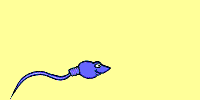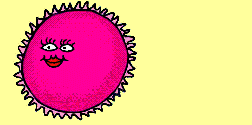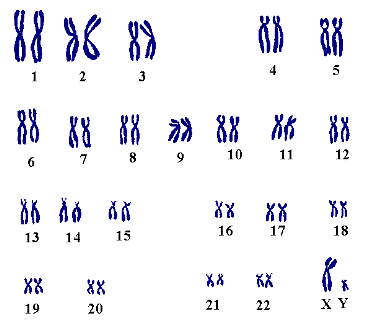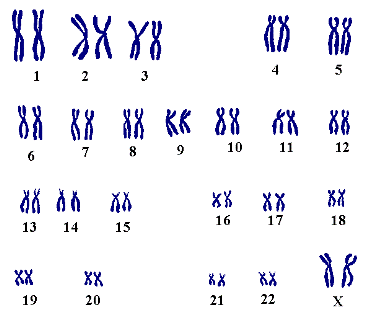Home
Genetics
Genetic
Crosses
History
Glossary
Puzzles
About
this site
Site
map
WebQuest
|
Where do you get your genes from?
You get your genes from your biological parents.
-
Your mother
contributes
one set of 23 chromosomes from her egg.
-
Your father
contributes
another set of 23 chromosomes from his sperm.
-
In this way, you have
23 pairs of chromosomes (46 altogether). They are said to be homologous
pairs.



-
The two chromosomes
of each pair carry genes that control the same characteristics in the
same positions. You therefore have two copies of each gene. One from
your mother and one from your father.
-
There is an exception
to this rule. While females do have 23 matched pairs of chromosomes,
one of the male's pairs are not matched. These are called the sex
chromosomes.
-
Females have two
large chromosomes called X chromosomes, while males have one X
chromosome and a smaller one called the Y chromosome.
-
The Y chromosome does
not carry many genes - only ones that make the individual grow into a
male. The X chromosome has hundreds of genes which control all sorts of
characteristics, most of them have no effect on gender.
Karyotypes
-
The pictures below
show karyotypes of a male and female. A karyotype is a picture made by
squashing a cell just before it divides (to spread out the coiled up
chromosomes), photographing the
results, then cutting around the images of the chromosomes and
arranging them in homologous pairs, in order of size.
 
-
Here
is a karyotype
of a human which has
been made by treating the
chromosomes with a stain that sticks to only certain parts of them.
This makes it easier to tell the pairs apart from other pairs of a
similar size.
-
This
is another
karyotype that uses stylised
drawings to show the banding pattern on chromosomes.
-
At the Human
Genome Project Information site
you can click on a picture of any one of our chromosomes and
see a list of selected traits and disorders associated with that
chromosome. This is their picture of chromosome number 1.
Does
the number of chromosomes matter?
-
Humans should have 46
chromosomes. Individuals born with any other number do usually show
harmful effects.
-
Each
species has a characteristic number of chromosomes, but many share the
same number. For example, New Zealand native Karaka trees and poroporo
shrubs happen to have 46, as does Kirk's dik dik (an African species of
antelope).
-
What
is most important is having genes that control the same characteristics
at the same places on homologous chromosomes.
- Below
is a list of species with their
chromosome numbers.
| Plants |
Animals |
kauri
rimu
totara
karaka
beech
kowhai
tawa
pine
|
26
20
34
46
26
18
24
24 |
onion
rice
corn
tomato
garden pea
potato
clover
yeast
|
16
24
20
24
14
48
32
8
|
human
chimp
gorilla
cow
dog
cat
horse
mouse |
46
48
48
60
78
38
64
40 |
sheep
pig
chicken
goldfish
house fly
mosquito
honeybee
red ant |
54
38
78
94
12
6
32
48 |
-
The full number of
chromosomes of a species is called its diploid
number,
while the half-number found in its gametes (= sperm or eggs)
is called its haploid
or monoploid
number.
-
It is also common to call the monoploid number of a
species (or its number of pairs of chromosomes), n. So for humans, n = 23. There is a
pretty good chance that you are a 2n individual - meaning you have 46
chromosomes.
-
If you are a gorilla however, for you n = ____? and
2n = ____?
How
do genes work?
-
Genes store
information that is used in the making of proteins.
-
Proteins have a
number of jobs to do in cells.
-
Some are structural,
they form solid structures such as hair, skin and muscle
fibres.
- Others
help transport materials within an organism. For example, haemoglobin
in red blood cells helps carry oxygen.
-
The majority of
proteins are enzymes. In order to stay alive, cells carry out many
chemical reactions. Enzymes are biological catalysts that
help these reactions take place.
-
You may have heard
that enzymes help you digest food, this is just one job. Other enzymes
are used to build-up or break-down hundreds of chemicals inside cells.
Each reaction requires a different enzyme to help it take place.
-
When
an enzyme is needed, a copy of the information on the appropriate gene
is made and moves out into the cell where it is "decoded" and helps in
the making of the right protein to do the job.
-
The enzyme must be
exactly the right structure to do its job. If the gene has a mistake in
it, it may code for the wrong protein and the job may not be done, or
done differently than usual.
-
Any
change to a chromosome or gene is called a mutation.
-
You may have heard of
albinos - these are people or animals with no pigmentation (examples: people
moose,
squirrel,
koala,
hedgehog.
Melanin is a pigment which gives colour to animals. It is made when
enzymes act on a substance called tyrosine to turn it into melanin.
People or animals whose genes do not code for the right enzyme, can not
make melanin and therefore lack pigmentation.
-
The good news is that
we usually have 2 copies of each gene so even if the one you got from
one parent doesn't work, hopefully the gene from the other parent does
work so that you don't suffer any ill effects.
-
Geneticists use the
word alleles
to describe different forms of a gene. For example, eye colour
is controlled by genes. One person may have alleles (forms of the gene
for eye colour) that give them blue eyes. Another person may have
alleles that give them brown coloured eyes. Having a mixture of alleles
may result in other colours. (More on that later)
-
In many cases the
different alleles for a gene all work in
some way without harming the individual. They produce variation
within a population of a species. E.g. a range of colours, sizes and
abilities. This is considered to be a good thing. Having variety in a
species means that if conditions change, some individuals may be able
to still survive. If they were all the same, whole populations
might be wiped out by a change such as cooling, warming or loss of a
certain food supply.

|
 A site for
learning
about basic genetics
A site for
learning
about basic genetics A site for
learning
about basic genetics
A site for
learning
about basic genetics





